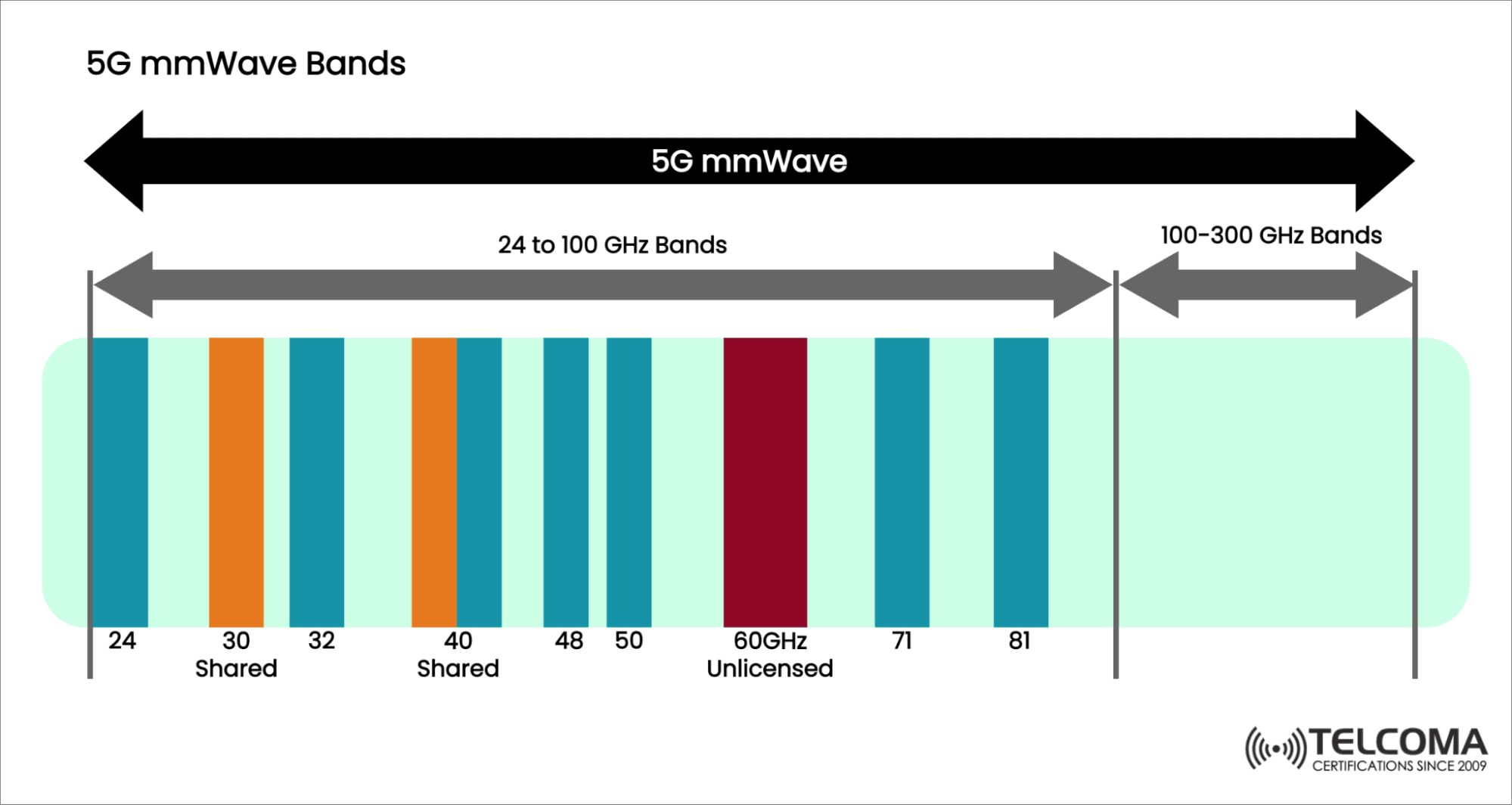Millimetre-wave communications


Millimeter-wave (mmWave) communications refer to the use of electromagnetic waves with frequencies between 30 GHz and 300 GHz for wireless communication. The mmWave spectrum lies between microwave and infrared wavelengths, and is an emerging technology for high-speed, low-latency wireless communication systems. It has the potential to revolutionize the way we communicate, enabling a range of applications that were previously not possible or feasible. In this article, we will discuss mmWave communications in detail, covering its technical aspects, advantages, challenges, and future prospects.
Introduction to mmWave Communications
The mmWave spectrum has remained largely unexplored until recently due to several challenges associated with its use. One of the primary challenges is the high attenuation of mmWave signals, which makes it difficult to transmit over long distances. Additionally, mmWave signals are susceptible to blockage by physical objects such as buildings, trees, and even people. However, advances in antenna technology, signal processing, and device design have enabled the development of mmWave communication systems that can overcome these challenges.
The high-frequency nature of mmWave signals enables high data rates, low latency, and massive bandwidths. This makes mmWave communication systems ideal for a range of applications such as 5G and 6G networks, high-speed wireless backhaul, and wireless virtual and augmented reality (VR/AR) applications. In the following sections, we will discuss the technical aspects of mmWave communications, including its frequency bands, antenna technologies, modulation schemes, and channel characteristics.
Frequency Bands
The mmWave spectrum is typically divided into several frequency bands, each with its unique characteristics and applications. The following table summarizes the different mmWave frequency bands:
| Frequency Band | Frequency Range | Applications |
|---|---|---|
| V-band | 40-75 GHz | Point-to-point wireless backhaul, wireless fiber extensions |
| E-band | 60-90 GHz | Point-to-point wireless backhaul, wireless fiber extensions |
| W-band | 75-110 GHz | Imaging, radar, and sensing applications |
| F-band | 90-140 GHz | Imaging, radar, and sensing applications |
| D-band | 110-170 GHz | Imaging, radar, and sensing applications |
| G-band | 140-220 GHz | Imaging, radar, and sensing applications |
The V-band and E-band are the most widely used mmWave frequency bands for wireless communication. The V-band is typically used for point-to-point wireless backhaul and wireless fiber extensions, while the E-band is used for high-capacity point-to-point wireless backhaul. The W-band, F-band, D-band, and G-band are less commonly used for wireless communication and are primarily used for imaging, radar, and sensing applications.
Antenna Technologies
The design of mmWave antennas is critical for the performance of mmWave communication systems. The high-frequency nature of mmWave signals requires antennas that can efficiently radiate and receive electromagnetic waves. The following are some of the commonly used mmWave antenna technologies:
- Microstrip Antennas - Microstrip antennas are planar antennas that consist of a metal patch on a dielectric substrate. They are widely used in mmWave communication systems due to their low profile, ease of fabrication, and compatibility with integrated circuits.
- Horn Antennas - Horn antennas are widely used in mmWave communication systems for their high gain and directional radiation pattern. They consist of a flared metal waveguide that narrows towards the aperture, which radiates electromagnetic waves.
- Patch Antennas - Patch antennas are widely used in mmWave communication systems for their simplicity, compactness, and low cost. They consist of a metal patch on a grounded substrate that radiates electromagnetic waves.
- Slot Antennas - Slot antennas are similar to patch antennas, but instead of a metal patch, they consist of a slot on a grounded substrate that radiates electromagnetic waves. They are widely used in mmWave communication systems due to their low profile and ease of integration.
- Array Antennas - Array antennas consist of multiple antenna elements arranged in a specific pattern to achieve high gain, directional radiation, and beamforming. They are commonly used in mmWave communication systems to overcome the challenges associated with the high attenuation and blockage of mmWave signals.
Modulation Schemes
The high-frequency nature of mmWave signals enables high data rates, but also introduces challenges such as high signal attenuation and susceptibility to blockage. To overcome these challenges, mmWave communication systems use advanced modulation schemes that can efficiently use the available bandwidth and mitigate the effects of signal attenuation and blockage. The following are some of the commonly used mmWave modulation schemes:
- Orthogonal Frequency Division Multiplexing (OFDM) - OFDM is a widely used modulation scheme in mmWave communication systems that divides the available bandwidth into multiple subcarriers that are orthogonal to each other. This enables efficient use of the available bandwidth and provides resilience to multipath fading.
- Single Carrier Frequency Division Multiple Access (SC-FDMA) - SC-FDMA is a modulation scheme that is used in mmWave communication systems for uplink transmission. It uses a single carrier waveform that is frequency modulated by the data symbols of multiple users, enabling multiple users to share the same frequency band.
- Multiple Input Multiple Output (MIMO) - MIMO is a technology that is used in mmWave communication systems to increase the data rate and improve the reliability of wireless communication. It uses multiple antennas at the transmitter and receiver to create multiple parallel data streams that can be transmitted and received simultaneously.
Channel Characteristics
The high-frequency nature of mmWave signals introduces unique channel characteristics that need to be considered when designing mmWave communication systems. The following are some of the channel characteristics of mmWave signals:
- Line of Sight (LOS) - mmWave signals have a high susceptibility to blockage by physical objects such as buildings, trees, and even people. Therefore, mmWave communication systems typically require a clear line of sight between the transmitter and receiver.
- Short Range - mmWave signals have high signal attenuation, which limits their range compared to lower frequency signals. Therefore, mmWave communication systems are typically designed for short-range communication.
- Multipath Fading - mmWave signals can experience multipath fading due to reflections and scattering from physical objects in the environment. Therefore, mmWave communication systems typically use advanced modulation schemes such as OFDM to mitigate the effects of multipath fading.
Advantages of mmWave Communications
The high-frequency nature of mmWave signals enables high data rates, low latency, and massive bandwidths, making mmWave communication systems ideal for a range of applications such as 5G and 6G networks, high-speed wireless backhaul, and wireless VR/AR applications. The following are some of the advantages of mmWave communications:
- High Data Rates - mmWave communication systems can achieve data rates of several gigabits per second, enabling high-bandwidth applications such as video streaming, virtual reality, and online gaming.
- Low Latency - mmWave communication systems have low latency, enabling real-time applications such as augmented reality, autonomous vehicles, and remote surgery.
- Massive Bandwidths - mmWave communication systems can use massive bandwidths of several gigahertz, enabling high-capacity wireless backhaul and point-to-point communication.
- Energy Efficiency - mmWave communication systems are typically more energy-efficient than lower frequency communication systems, enabling longer battery life for mobile devices.
Challenges of mmWave Communications
Despite the advantages, mmWave communication systems also face several challenges that need to be addressed to enable widespread adoption. The following are some of the challenges of mmWave communications:
- Limited Range - mmWave signals have high signal attenuation, which limits their range compared to lower frequency signals. Therefore, mmWave communication systems typically require a large number of small cells to achieve wide coverage.
- Susceptibility to Blockage - mmWave signals are susceptible to blockage by physical objects such as buildings, trees, and even people. Therefore, mmWave communication systems typically require a clear line of sight between the transmitter and receiver, which can be challenging in urban environments.
- High Power Consumption - mmWave communication systems require higher transmit power than lower frequency communication systems to overcome the high signal attenuation and achieve wide coverage. This can result in higher power consumption and reduced battery life for mobile devices.
- Interference - mmWave communication systems can be susceptible to interference from other wireless devices and sources such as weather radars and satellites.
Applications of mmWave Communications
mmWave communications have several applications in various fields such as telecommunication, wireless backhaul, and automotive industries. The following are some of the applications of mmWave communications:
- 5G and 6G Networks - mmWave communication systems are a key technology in 5G and 6G networks, enabling high-speed wireless communication with low latency and massive bandwidths.
- Wireless Backhaul - mmWave communication systems can be used for high-capacity wireless backhaul for small cells and base stations, enabling cost-effective deployment of cellular networks.
- Virtual Reality and Augmented Reality - mmWave communication systems can enable immersive virtual reality and augmented reality experiences with high data rates and low latency.
- Autonomous Vehicles - mmWave communication systems can enable reliable and low-latency communication between autonomous vehicles and infrastructure, improving safety and enabling new applications such as platooning and traffic management.
Conclusion
mmWave communication systems have emerged as a key technology for high-speed wireless communication with low latency and massive bandwidths. They use advanced technologies such as beamforming, MIMO, and advanced modulation schemes to overcome the challenges associated with the high-frequency nature of mmWave signals. However, they also face several challenges such as limited range, susceptibility to blockage, and high power consumption that need to be addressed to enable widespread adoption. With continued research and development, mmWave communication systems have the potential to enable new applications and transform various industries.
